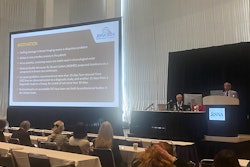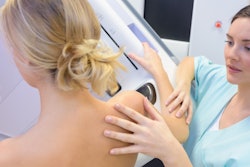AI scoring could help predict future breast cancer risk and identify high-risk women, suggest findings published October 3 in JAMA Network Open.
Researchers led by Solveig Hofvind, PhD, from the Norwegian Institute of Public Health in Oslo found that absolute average AI scores based on commercially available algorithms were higher for breasts developing cancer versus not developing cancer four to six years before their eventual detection on screening mammography.
“These findings suggest that commercial AI algorithms developed for breast cancer detection may identify women at high risk of a future breast cancer, offering a pathway for personalized screening approaches that can lead to earlier cancer diagnosis,” Hofvind and co-authors wrote.
Breast imaging experts agree that early breast cancer detection leads to better prognosis and treatment outcomes. Screening mammography remains the gold standard in detecting breast cancer, but researchers continue to explore different methods of improving the modality’s accuracy.
AI is one avenue of interest in recent years, with the technology demonstrating promise as a reading assistant for breast imagers. The Hofvind team studied whether a commercially available AI algorithm for detecting breast cancer (Insight MMG, version 1.1.7.2; Lunit) could predict future cancer development in women.
The study included 116,495 women aged 50 to 69 years who did not have a prior history of breast cancer before they underwent at least three consecutive biennial screening mammography exams. Using exam data from between 2004 and 2018, the team evaluated the AI algorithm in 2022 and 2023. The algorithm provided a continuous cancer detection score for each exam ranging from zero to 100, with higher scores translating to a higher likelihood of cancer on the mammogram.
The researchers found that the average absolute difference in AI scores among breasts of women developing screen-detected cancer increased over the three screening rounds. They observed similar trends for average differences prior to interval cancer and moderate area under the receiver operating characteristic (AUROC) curve values.
| AI scoring among 3 consecutive biennial breast cancer screening rounds | |||
|---|---|---|---|
| Measure | 1st round | 2nd round | 3rd round |
| Average absolute difference (screen-detected cancers) | 21.3 | 30.7 | 79 |
| Average differences (prior to interval cancers) | 19.7 | 21 | 34 |
| Average difference (women who did not develop cancer) | 9.9 | 9.6 | 9.3 |
| AUROC (absolute difference, screen-detected cancers) | 0.63 | 0.72 | 0.96 |
| AUROC (difference for interval cancers) | 0.64 | 0.65 | 0.77 |
The study authors noted that the trend for higher AI scores among consecutive screening rounds suggests that interval cancers develop faster and may be less likely to show suspicious features on screening mammograms compared with screening-detected cancers. This indicates that many interval cancers “are truly mammographically occult at the time of screening and may not be detectable by the interpreting radiologists,” the authors added.
“The increasing difference in AI scores by time and between the breasts could be used by interpreting radiologists to indicate elevated risk of developing breast cancer and to suggest supplemental screening or annual mammography screening,” they noted.
The team wrote that its future research will evaluate the location of markings flagged by the AI cancer detection tool and examine images interpreted as negative by radiologists but are in women who eventually have breast cancers diagnosed. This will be performed to determine whether AI markings can help guide targeted supplemental screening.
“In addition, risk estimation models could be developed based on AI scores and differences in the AI scores for the two breasts over time and other factors, such as age, mammographic density, and prior benign breast biopsies, to provide an individual risk estimation for women regularly receiving mammography screening,” it wrote.
The full results can be found here.



















